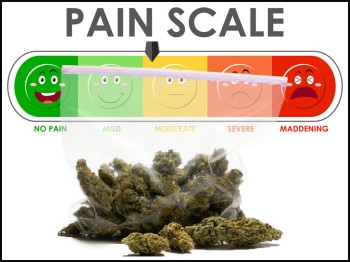Why People (and Worms) Get the Munchies After Using Cannabis
After consuming cannabis, many individuals experience an uptick in their hunger, commonly known as munchies. This phenomenon is so widely recognized that it often appears in movies and TV shows, depicting people developing an insatiable craving for food after smoking cannabis.
However, the munchies are not a mere myth. Cannabis possesses the ability to stimulate people's appetite and cravings. Let's delve deeper into the mechanisms through which it triggers this effect.
Why Does Cannabis Make People Hungry?
Cannabis impacts appetite through two distinct mechanisms. Firstly, it can enhance the flavor of food, making it more appealing and increasing the likelihood of consumption. Secondly, it can deceive the brain into perceiving hunger signals, even when you have recently eaten.
When cannabinoids, the active constituents in cannabis, attach to specific receptors in the body, they produce distinct effects. Upon binding to receptors on your tongue, they augment the brain's reaction to sweet-tasting food and intensify the craving for fatty foods. Furthermore, a clinical investigation indicated that inhaling cannabis can boost the production of hormones responsible for triggering hunger.
It is important to note that not all cannabis products induce hunger, as the impact on appetite levels depends on the activation of specific receptors. The primary cannabinoid responsible for stimulating appetite is tetrahydrocannabinol (THC), whereas other cannabinoids may not activate the receptors that regulate hunger.
While THC is the primary cannabinoid known to enhance appetite, it is just one of over 100 active chemicals in cannabis. Animal research has revealed that cannabigerol (CBG), another cannabinoid, may also trigger hunger without causing the intoxicating effects of THC. This makes CBG an attractive study area for researchers seeking to stimulate appetite without the associated high produced by THC.
How Long Do the Munchies Last?
The duration of munchies following cannabis consumption can be challenging to determine precisely. The quantity and mode of consumption are significant factors that affect the course of the effects.
For instance:
Inhaling or Smoking Cannabis: This method causes cannabis to achieve its peak concentration in the brain within 3 to 10 minutes and typically subsides within 2 to 3 hours.
Consuming cannabis orally: When cannabis is ingested, it may take up to 2 hours to attain its maximum concentration in the brain. However, its effects may last 6 to 8 hours, sometimes even longer. It is worth noting that individuals may react differently to cannabis, and as a result, the duration and intensity of hunger may differ from the pattern above.
Worms Get The Munchies, Too
Recent research has uncovered that it's not only humans who experience the munchies; worms also demonstrate a similar fondness for their preferred treats following cannabis consumption.
According to Shawn Lockery, a researcher at the University of Oregon in Eugene, Cannabinoids increase the appetite of nematodes for their preferred foods while simultaneously reducing their hunger for non-preferred foods. As such, the impact of cannabinoids on nematodes aligns with the effects of marijuana on human appetites.
He added, "Nematodes separated from the mammalian evolutionary lineage over 500 million years ago. It's astounding that the influence of cannabinoids on appetite has persisted for such an extended period."
Lockery clarified that the study's genesis dates back to 2015, following the legalization of cannabis in Oregon. He remarked that at that time, the laboratory at the University of Oregon was engrossed in analyzing nematode food preferences as part of our study on the neural underpinnings of economic decision-making.
In a 'Friday afternoon experiment' that was almost too impulsive, they decided to immerse worms in cannabinoids to explore if it affects their current food choices. Astonishingly, it did! And after years of follow-up research, the findings are finally documented in this paper.
Cannabinoids exert their effects by attaching to cannabinoid receptors, detector proteins in the brain, nervous system, and other bodily tissues. These receptors typically react to endocannabinoids, naturally occurring molecules in the body. The endocannabinoid system governs various crucial functions, including eating, memory and learning, anxiety, metabolism, and reproduction.
The molecular structure of the cannabinoid system in nematodes bears a striking resemblance to that in humans and other creatures. This prompted whether the appetite-stimulating effects of cannabinoids, known as "hedonic feeding," would also be preserved across different species.
Details of the Experiment
In the latest study, scientists initially demonstrated that nematodes respond to the endocannabinoid anandamide by consuming more food, particularly their preferred type. The team also discovered that the effects of endocannabinoids on the worms were contingent on the existence of their cannabinoid receptors.
The researchers conducted additional studies where they genetically modified the cannabinoid receptor of C. elegans with the human cannabinoid receptor. They discovered that the worms responded as expected to cannabinoids. This finding highlights the similarity in the effects of cannabinoids in both nematodes and humans. The team also found that the effects of anandamide relied on neurons involved in detecting food.
Lockery explained that cannabinoids cause a significant change in the sensitivity of a crucial olfactory neuron responsible for detecting food in C. elegans. The neuron becomes more responsive to pleasant and less responsive to unpleasant food smells. This phenomenon clarifies the variations in the worm's food intake, similar to how THC enhances the flavor of delectable foods in humans.
According to Lockery, the discoveries in C. elegans are interesting and hold immense practical implications. He stated that cannabinoid signaling is widespread across various tissues in the human body, indicating its potential involvement in developing and managing numerous diseases.
The functionality of the human cannabinoid receptor gene in C. elegans' food preference studies creates an opportunity for swift and cost-effective screening of drugs that aim to target diverse proteins linked to cannabinoid signaling and metabolism. This has significant implications for human health.
Conclusion
The research on how cannabinoids affect nematodes reveals fresh information about the evolutionary preservation of the endocannabinoid system and its function in controlling hunger in many species. The effects of cannabis on appetite seem to be the same in worms and humans, pointing to a highly conserved mechanism in the brain and neurological system.
This study opens up new avenues for studying the intricate interplay between cannabis and appetite regulation, which may help create fresh remedies for diseases like cachexia and anorexia. Realizing that nematodes also have food needs can cause some people to reevaluate their opinion of these microscopic critters, transforming them from unrelatable soil-dwelling organisms to relatable beings with similar appetites.








